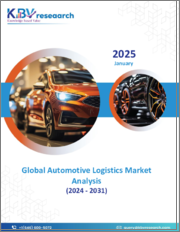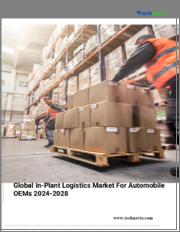
|
시장보고서
상품코드
1577063
공장내 물류 시장, 기회, 성장 촉진요인, 산업 동향 분석과 예측(2024-2032년)In-Plant Logistics Market, Opportunity, Growth Drivers, Industry Trend Analysis and Forecast, 2024-2032 |
||||||
세계의 공장내 물류 시장은 2023년에 116억 5,000만 달러로 평가되며, 2024-2032년의 CAGR은 10%를 넘는 성장이 예측됩니다.
이러한 성장의 원동력은 다양한 산업에서 자동화 및 디지털화 도입이 진행되고 있기 때문입니다. 지속가능성과 환경 규제는 공장내 물류 시장의 중요한 촉진요인입니다. 기업은 탄소 배출량을 줄이고 엄격한 환경법을 준수하기 위해 환경 친화적인 솔루션을 찾고 있습니다. 에너지 소비를 최소화하고 폐기물을 줄이며 자원 활용을 개선하는 공장내 물류 시스템에 대한 수요가 높습니다. 이러한 지속가능한 관행은 환경 보호에 기여할 뿐만 아니라 기업 이미지와 브랜드 가치를 향상시킬 수 있습니다.
제조 공정의 유연성과 확장성에 대한 요구도 시장 성장을 가속하고 있습니다. 시장이 더욱 역동적이고 고객의 요구가 더욱 다양해짐에 따라 기업은 생산량과 제품 유형 변화에 신속하게 대응할 수 있는 물류 시스템을 필요로 하고 있습니다.
산업별로는 자동차, 소매 및 소비재, 식품 및 음료, 금속 및 중장비, 전자, 기타 등이 있습니다. 자동차 분야는 세계 인구 증가와 소비자 소득 증가에 힘입어 2032년까지 100억 달러를 넘어설 것으로 예상됩니다. 제조업체들은 복잡한 공급망을 효율적으로 관리하기 위해 첨단 물류 솔루션에 투자하고 있습니다.
도입 형태에 따라 시장은 온프레미스형, 클라우드 기반, 하이브리드형으로 나뉩니다. 클라우드 기반 부문이 가장 빠르게 성장하고 있으며, 2024-2032년 연평균 복합 성장률(CAGR)이 10%를 상회할 것으로 예상됩니다. 클라우드 기반 솔루션은 온프레미스 솔루션에 비해 확장성이 뛰어나고 초기 투자가 적기 때문에 공장내 물류의 역동적인 환경에서 특히 가치가 높습니다.
2023년 세계 공장내 물류 시장은 북미가 35% 이상의 점유율을 차지할 것으로 예상됩니다. 이 지역의 첨단 제조업은 대량 생산과 복잡한 공급망을 특징으로 하며, 효율적인 물류 솔루션을 필요로 합니다. 자동화, 로봇 공학, 인공지능과 같은 첨단 기술의 도입으로 업무 효율성과 정확성이 향상되고 있습니다. 미국 시장은 탄탄한 제조 부문과 기술 발전으로 인해 번영을 누리고 있습니다. 많은 제조 시설들이 자동화 및 클라우드 기반 물류 솔루션에 투자하여 업무 간소화와 효율화를 위해 노력하고 있습니다.
중국 시장은 제조업의 현대화와 디지털화를 적극적으로 추진하면서 빠르게 성장하고 있습니다. 스마트 제조와 인더스트리 4.0 추진에 대한 정부의 의지가 첨단 물류 기술에 대한 투자를 촉진하고 있습니다.
한국 시장은 기술과 혁신을 중시하는 한국 정부의 구상에 힘입어 강력한 성장세를 보이고 있습니다. 전자 및 자동차 제조의 선두주자로서 한국은 자동화 및 스마트 팩토리 기술에 많은 투자를 하고 있습니다.
일본 시장은 자동화와 첨단 제조 기술에 대한 집중으로 성장하고 있습니다. 로봇 공학, AI 및 IoT 기술을 물류 업무에 통합하여 프로세스를 간소화하고 효율성을 향상시키고 있습니다.
목차
제1장 조사 방법과 조사 범위
제2장 개요
제3장 업계 인사이트
- 에코시스템 분석
- 공급업체 상황
- 소프트웨어 프로바이더
- 물류·서비스·프로바이더
- 테크놀러지 프로바이더
- 최종사용자
- 이익률 분석
- 테크놀러지와 혁신 전망
- 특허 분석
- 주요 뉴스와 구상
- 규제 상황
- 영향요인
- 촉진요인
- 인더스트리 4.0과 스마트 공장의 도입 확대
- 제조 프로세스의 복잡화
- 물류 업계에서 기술의 진보
- 물류 기업의 비용 삭감에 대한 관심의 증가
- 업계의 잠재적 리스크 & 과제
- 업무 효율의 과제
- 공급망 혼란
- 촉진요인
- 성장 가능성 분석
- Porter의 산업 분석
- PESTEL 분석
제4장 경쟁 구도
- 서론
- 기업 점유율 분석
- 경쟁 포지셔닝 매트릭스
- 전략 전망 매트릭스
제5장 시장 추산·예측 : 서비스 유형별, 2021-2032년
- 주요 동향
- 자재관리
- 운송 관리
- 재고 관리
- 포장·라벨링
- 기타
제6장 시장 추산·예측 : 시설 규모별, 2021-2032년
- 주요 동향
- 소규모 시설
- 중규모 시설
- 대규모 시설
제7장 시장 추산·예측 : 최종사용자별, 2021-2032년
- 주요 동향
- 일렉트로닉스
- 식품 및 음료
- 자동차
- 항공우주·방위
- 화학
- 기타
제8장 시장 추산·예측 : 지역별, 2021-2032년
- 주요 동향
- 북미
- 미국
- 캐나다
- 유럽
- 영국
- 독일
- 프랑스
- 이탈리아
- 스페인
- 북유럽
- 기타 유럽
- 아시아태평양
- 중국
- 인도
- 일본
- 한국
- 뉴질랜드
- 동남아시아
- 기타 아시아태평양
- 라틴아메리카
- 브라질
- 멕시코
- 아르헨티나
- 기타 라틴아메리카
- 중동 및 아프리카
- 남아프리카공화국
- 사우디아라비아
- 아랍에미리트
- 기타 중동 및 아프리카
제9장 기업 개요
- Baumer
- Crown Equipment Corporation
- Daifuku Co., Ltd.
- Honeywell International, Inc.
- Interroll Group
- John Bean Technologies Corp.
- Jungheinrich AG
- KION Group AG
- Knapp AG
- KUKA AG
- Mecalux, S.A.
- Mitsubishi Logisnext Co., Ltd.
- Murata Machinery Ltd.
- SICK AG
- SSI Schafer
- TGW Logistics
- Toyota Industries Corporation
The Global In-Plant Logistics Market, valued at USD 11,650.0 million in 2023, is projected to grow at a CAGR exceeding 10% from 2024 to 2032. This growth is driven by the increasing adoption of automation and digitalization across various industries. Sustainability and environmental regulations are significant drivers for the in-plant logistics market. Companies are seeking eco-friendly solutions to reduce their carbon footprint and comply with stringent environmental laws. In-plant logistics systems that minimize energy consumption, reduce waste, and improve resource utilization are in high demand. These sustainable practices not only contribute to environmental conservation but also enhance corporate image and brand value.
The need for flexibility and scalability in manufacturing processes is also fueling market growth. As markets become more dynamic and customer demands more variable, companies require logistics systems that can quickly adapt to changing production volumes and product varieties.
By industry vertical, the market includes automobiles, retail & consumer goods, food & beverages, metals & heavy machinery, electronics, and others. The automobiles segment is expected to surpass USD 10 billion by 2032, driven by global population growth and rising consumer income. Manufacturers are investing in advanced logistics solutions to manage complex supply chains efficiently.
By deployment mode, the market is divided into on-premises, cloud-based, and hybrid solutions. The cloud-based segment is the fastest-growing, with a CAGR exceeding 10% from 2024 to 2032. Cloud-based solutions offer significant scalability and lower upfront investments compared to on-premises solutions, making them particularly valuable in the dynamic environment of in-plant logistics.
North America dominated the global in-plant logistics market in 2023, accounting for over 35% of the share. The region's advanced manufacturing sector, characterized by high production volumes and complex supply chains, demands efficient logistics solutions. The adoption of cutting-edge technologies such as automation, robotics, and artificial intelligence is enhancing operational efficiency and accuracy. The U.S. market is thriving due to its robust manufacturing sector and technological advancements. Numerous manufacturing facilities are investing in automated and cloud-based logistics solutions to streamline operations and enhance efficiency.
China's market is expanding rapidly due to the country's aggressive push towards manufacturing modernization and digitalization. The government's commitment to advancing smart manufacturing and Industry 4.0 is driving investments in advanced logistics technologies.
South Korea's market is experiencing robust growth, fueled by the country's strong emphasis on technology and innovation. As a leader in electronics and automotive manufacturing, South Korea is investing heavily in automation and smart factory technologies.
Japan's market is growing due to the country's focus on automation and advanced manufacturing techniques. The integration of robotics, AI, and IoT technologies into logistics operations is streamlining processes and improving efficiency.
Table of Contents
Chapter 1 Methodology and Scope
- 1.1 Research design
- 1.1.1 Research approach
- 1.1.2 Data collection methods
- 1.2 Base estimates and calculations
- 1.2.1 Base year calculation
- 1.2.2 Key trends for market estimation
- 1.3 Forecast model
- 1.4 Primary research and validation
- 1.4.1 Primary sources
- 1.4.2 Data mining sources
- 1.5 Market definitions
Chapter 2 Executive Summary
- 2.1 Industry 360° synopsis, 2021 - 2032
Chapter 3 Industry Insights
- 3.1 Industry ecosystem analysis
- 3.2 Supplier landscape
- 3.2.1 Software providers
- 3.2.2 Logistics service providers
- 3.2.3 Technology providers
- 3.2.4 End-user
- 3.3 Profit margin analysis
- 3.4 Technology and innovation landscape
- 3.5 Patent analysis
- 3.6 Key news and initiatives
- 3.7 Regulatory landscape
- 3.8 Impact forces
- 3.8.1 Growth drivers
- 3.8.1.1 Growing deployment of Industry 4.0 and smart factories
- 3.8.1.2 Increasing complexity of manufacturing processes
- 3.8.1.3 Technological advancements in the logistics industry
- 3.8.1.4 Growing focus of logistics companies on cost reduction
- 3.8.2 Industry pitfalls and challenges
- 3.8.2.1 Operational efficiency challenges
- 3.8.2.2 Supply chain disruptions
- 3.8.1 Growth drivers
- 3.9 Growth potential analysis
- 3.10 Porter's analysis
- 3.11 PESTEL analysis
Chapter 4 Competitive Landscape, 2023
- 4.1 Introduction
- 4.2 Company market share analysis
- 4.3 Competitive positioning matrix
- 4.4 Strategic outlook matrix
Chapter 5 Market Estimates and Forecast, By Service Type, 2021 - 2032 ($Bn)
- 5.1 Key trends
- 5.2 Material handling
- 5.3 Transportation management
- 5.4 Inventory management
- 5.5 Packaging and labelling
- 5.6 Others
Chapter 6 Market Estimates and Forecast, By Facility Size, 2021 - 2032 ($Bn, 000' tons)
- 6.1 Key trends
- 6.2 Small facilities
- 6.3 Medium facilities
- 6.4 Large facilities
Chapter 7 Market Estimates and Forecast, By End User, 2021 - 2032 ($Bn, 000' tons)
- 7.1 Key trends
- 7.2 Electronics
- 7.3 Food and beverage
- 7.4 Automotive
- 7.5 Aerospace and defense
- 7.6 Chemicals
- 7.7 Others
Chapter 8 Market Estimates and Forecast, By Region, 2021 - 2032 ($Bn, 000' tons)
- 8.1 Key trends
- 8.2 North America
- 8.2.1 U.S.
- 8.2.2 Canada
- 8.3 Europe
- 8.3.1 UK
- 8.3.2 Germany
- 8.3.3 France
- 8.3.4 Italy
- 8.3.5 Spain
- 8.3.6 Nordics
- 8.3.7 Rest of Europe
- 8.4 Asia Pacific
- 8.4.1 China
- 8.4.2 India
- 8.4.3 Japan
- 8.4.4 South Korea
- 8.4.5 ANZ
- 8.4.6 Southeast Asia
- 8.4.7 Rest of Asia Pacific
- 8.5 Latin America
- 8.5.1 Brazil
- 8.5.2 Mexico
- 8.5.3 Argentina
- 8.5.4 Rest of Latin America
- 8.6 MEA
- 8.6.1 South Africa
- 8.6.2 Saudi Arabia
- 8.6.3 UAE
- 8.6.4 Rest of MEA
Chapter 9 Company Profiles
- 9.1 Baumer
- 9.2 Crown Equipment Corporation
- 9.3 Daifuku Co., Ltd.
- 9.4 Honeywell International, Inc.
- 9.5 Interroll Group
- 9.6 John Bean Technologies Corp.
- 9.7 Jungheinrich AG
- 9.8 KION Group AG
- 9.9 Knapp AG
- 9.10 KUKA AG
- 9.11 Mecalux, S.A.
- 9.12 Mitsubishi Logisnext Co., Ltd.
- 9.13 Murata Machinery Ltd.
- 9.14 SICK AG
- 9.15 SSI Schafer
- 9.16 TGW Logistics
- 9.17 Toyota Industries Corporation



















